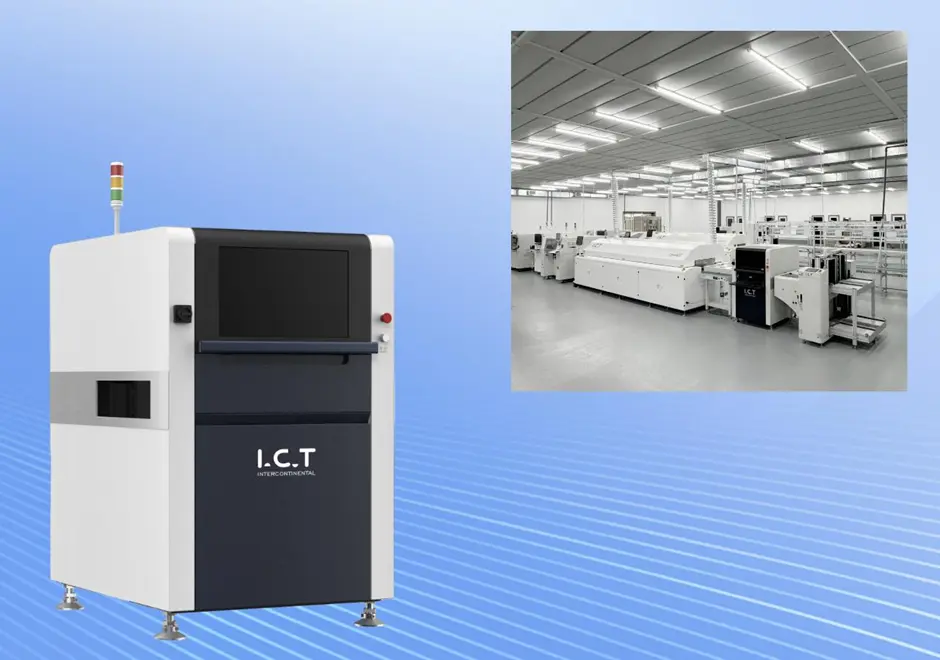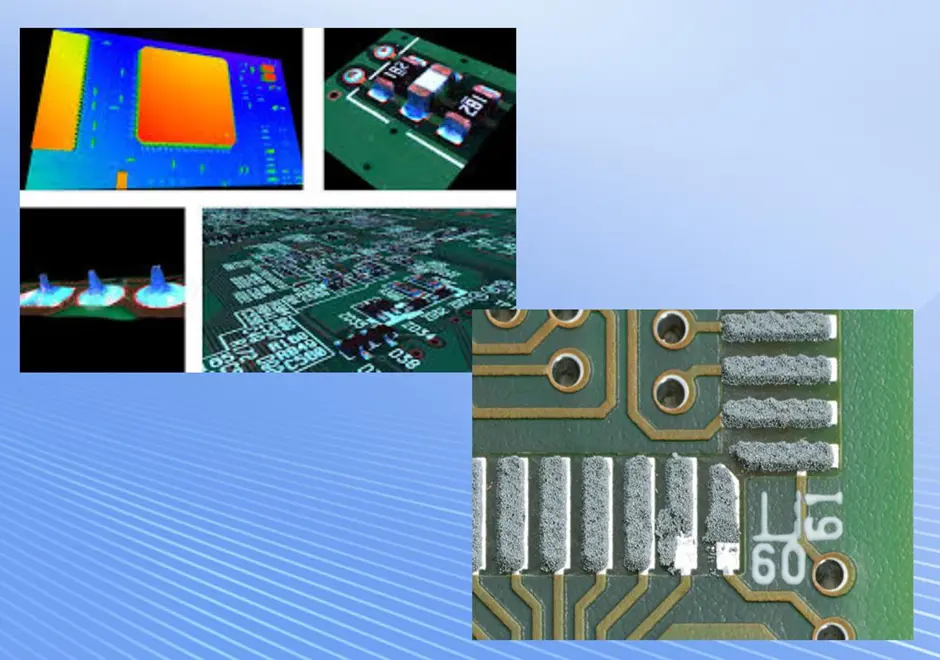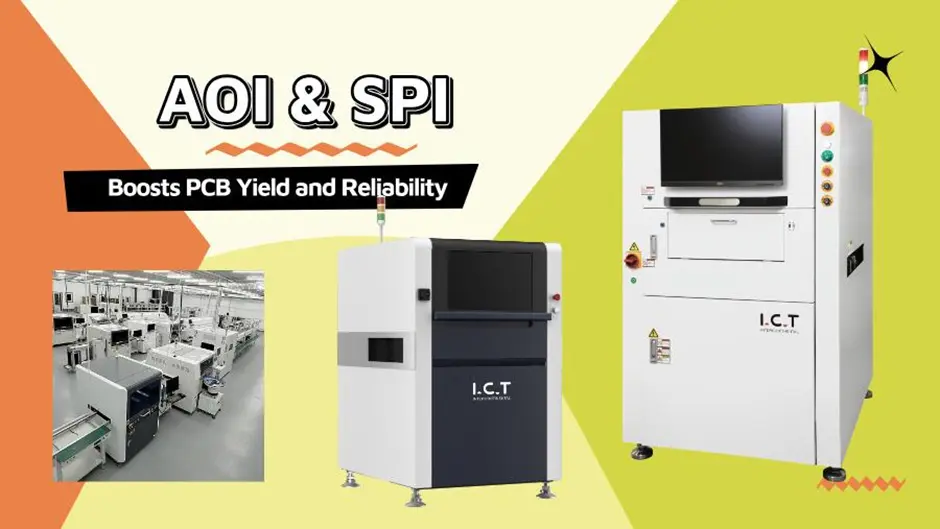Modern electronics manufacturing demands precision and efficiency, and SMT AOI SPI systems play a pivotal role in achieving defect-free printed circuit boards (PCB). Surface Mount Technology (SMT) production lines rely on Automated Optical Inspection (AOI) and Solder Paste Inspection (SPI) to catch errors early, reduce costly rework, and ensure high-quality output. By integrating these complementary tools, manufacturers can address common pain points like inconsistent soldering and component misalignment, ultimately boosting PCB yield and reliability. This article explores how AOI and SPI work together to streamline SMT processes and deliver consistent results.
1. Understanding AOI and SPI in SMT Processes
1.1. The Fundamentals of Automated Optical Inspection (AOI)

Automated Optical Inspection (AOI) uses high-resolution cameras and advanced algorithms to examine PCB after component placement or soldering. Positioned typically before or after the reflow oven in SMT lines, AOI scans for defects such as missing components, misaligned parts, or soldering issues like insufficient joints. By comparing captured images to a predefined standard, AOI systems, often powered by deep learning, deliver precise defect detection. This reduces the need for manual inspection, which is prone to human error and slows production, addressing a key manufacturer pain point: inconsistent quality control.
1.2. The Role of Solder Paste Inspection (SPI) in Early Defect Detection
Solder Paste Inspection (SPI) focuses on the critical first step of SMT: solder paste application. Placed before component placement, SPI systems use 2D or 3D imaging to verify the volume, height, and alignment of solder paste deposits on PCB pads. Issues like insufficient paste or bridging can lead to poor soldering, causing failures downstream. By catching these errors early, SPI minimizes rework costs, which can accumulate when defects are only detected after reflow, requiring time-consuming repairs or even scrapped boards.

1.3. How AOI and SPI Complement Each Other in SMT Lines
AOI and SPI serve distinct yet synergistic roles in SMT production. SPI ensures the foundation of soldering is correct, preventing issues that could compromise the entire assembly. AOI, positioned later, verifies the final assembly quality, catching defects that SPI cannot, such as component placement errors or post-reflow soldering flaws. Together, they form a robust quality control system, reducing the likelihood of defective PCB reaching the end of the line. This dual approach directly tackles manufacturer concerns about rework, as catching errors at multiple stages prevents costly fixes and improves overall production efficiency.
2. Key Differences Between AOI and SPI
2.1. Inspection Timing and Placement in the SMT Workflow
SPI operates at the start of the SMT process, immediately after solder paste printing, to ensure the paste meets specifications before components are placed. AOI, in contrast, is typically deployed post-placement or post-reflow to inspect the entire assembly. This timing difference means SPI prevents early-stage defects, while AOI addresses issues that emerge during or after soldering. For manufacturers, this staged approach reduces rework by catching errors at their source rather than discovering them late, when repairs are more labor-intensive and costly.

2.2. Detection Capabilities: What Each Tool Excels At
SPI excels at analyzing solder paste quality, detecting issues like uneven deposits or stencil misalignments that could lead to weak solder joints. AOI, however, has a broader scope, identifying component-related defects such as tombstoning, skewed parts, or solder bridges. While SPI focuses narrowly on paste, AOI’s versatility makes it essential for final quality checks. Together, they cover the full spectrum of SMT defects, ensuring manufacturers avoid the high costs of rework caused by missed errors in either stage.
2.3. Technology and Equipment Variations
SPI systems often employ 3D imaging to measure paste volume and height with precision, using technologies like laser triangulation or structured light. AOI systems rely on high-resolution cameras and may incorporate 2D or 3D inspection, with some advanced models using artificial intelligence to reduce false positives. Both systems vary in complexity, from compact units for small-scale production to high-speed machines for large-scale SMT lines. Manufacturers benefit from choosing equipment tailored to their production needs, minimizing downtime and rework by ensuring compatibility with their specific PCB designs.
3. Benefits of Dual AOI and SPI Implementation
3.1. Enhancing PCB Yield Through Proactive Error Reduction
By catching defects early with SPI and verifying assembly with AOI, manufacturers significantly increase PCB yield. Early detection of solder paste issues prevents defective boards from progressing, while AOI ensures the final product meets quality standards. This proactive approach reduces the volume of defective units, directly addressing the pain point of wasted materials and labor in rework-heavy processes. For high-volume production, even a small improvement in yield can translate to substantial savings.
3.2. Improving Reliability and Long-Term Product Performance
Consistent solder paste application and accurate component placement are critical for PCB reliability, especially in demanding applications like automotive or medical electronics. SPI ensures strong solder joints, while AOI confirms proper component alignment and soldering quality. Together, they reduce the risk of field failures, which can damage a manufacturer’s reputation and lead to costly recalls. This reliability focus alleviates concerns about product returns and enhances customer trust.
3.3. Cost Savings and Efficiency Gains in Production
Rework is a major cost driver in electronics manufacturing, often requiring skilled labor and halting production lines. By integrating AOI and SPI, manufacturers catch defects before they escalate, reducing the need for manual repairs or scrapped boards. This efficiency not only lowers labor costs but also keeps production schedules on track, addressing the pain point of delayed deliveries due to quality issues. The streamlined process also allows for better integration with Manufacturing Execution Systems (MES), enabling real-time data tracking and process optimization.
4. Real-World Applications and Case Studies
4.1. Integrating AOI and SPI in High-Volume SMT Manufacturing
In high-volume SMT lines, such as those producing consumer electronics, AOI and SPI are critical for maintaining throughput without sacrificing quality. For example, a consumer electronics supplier in Estonia integrated SPI before component placement and AOI post-reflow to ensure precise PCB assembly. This setup caught solder paste misalignments early and verified soldering quality, reducing rework by addressing defects at their source. Such applications demonstrate how dual inspection supports high-speed production while minimizing costly errors.
4.2. Challenges and Solutions in Dual Inspection Setups
Implementing AOI and SPI can present challenges, such as initial setup complexity or false positives in high-mix production. Manufacturers address these by selecting systems with user-friendly interfaces and remote programming capabilities, which simplify calibration. For instance, a smart meter producer in Uruguay used an AOI system with deep learning to reduce false alarms, streamlining inspections across varied PCB designs. These solutions help manufacturers overcome the pain point of time-consuming setups, ensuring smooth integration into existing lines.
4.3. Measuring Success: Metrics for Yield and Reliability
Manufacturers measure the success of AOI and SPI through metrics like First Pass Yield (FPY) and defect rates. By catching issues early, SPI improves FPY by ensuring proper solder paste application, while AOI minimizes escapes (defects missed during inspection). These metrics directly correlate to reduced rework costs and higher reliability, addressing manufacturer concerns about inconsistent output and customer complaints. Regular data tracking via MES integration further enhances process control, ensuring consistent improvements.
5. Leading Brands and Solutions in AOI and SPI
5.1. Established Players: Yamaha, Koh Young, and Viscom
Yamaha offers versatile AOI systems with high-speed cameras, ideal for complex PCB designs. Koh Young specializes in 3D SPI and AOI, providing precise solder paste and component inspections for high-reliability applications. Viscom delivers robust systems for both SMT and DIP lines, with advanced imaging for defect detection. These brands are trusted for their reliability and innovation, helping manufacturers reduce rework and maintain consistent quality across diverse production environments.
5.2. I.C.T Innovative Approach to SMT Inspection

I.C.T provides comprehensive AOI and SPI solutions tailored to SMT, DIP, and conformal coating lines. Their systems incorporate deep learning for accurate defect detection and minimal false positives, addressing manufacturer concerns about inspection reliability. With features like remote programming and MES integration, I.C.T. equipment supports efficient production, reducing setup time and rework costs. Their global support ensures manufacturers receive timely assistance, further minimizing downtime.
5.3. Selecting the Right System for Your Needs
Choosing the right AOI and SPI systems depends on production volume, PCB complexity, and budget. High-volume manufacturers may prioritize speed and 3D capabilities, while smaller operations might opt for compact, versatile units. Brands like I.C.T, Yamaha, Koh Young, and Viscom offer scalable solutions, allowing manufacturers to balance cost and performance. By selecting systems that align with specific needs, manufacturers can reduce rework and ensure reliable PCB output without over-investing.
6. Summary of Key Takeaways
AOI and SPI are indispensable for modern SMT production, addressing manufacturer pain points by reducing rework costs and improving PCB yield and reliability. SPI catches solder paste issues early, while AOI ensures final assembly quality, together minimizing defects and enhancing efficiency. Leading brands like Yamaha, Koh Young, Viscom, and I.C.T. offer advanced solutions that streamline inspection and support diverse production needs. By integrating these systems, manufacturers achieve consistent quality, lower costs, and reliable products, ensuring competitiveness in demanding electronics markets.
Also Read–How to Choose the Right Online Surgical Tech Program (And Avoid Scams)

